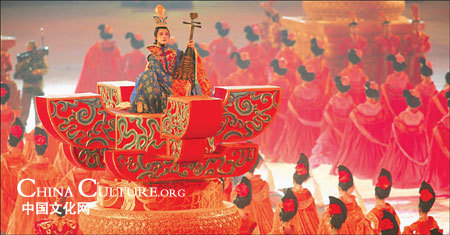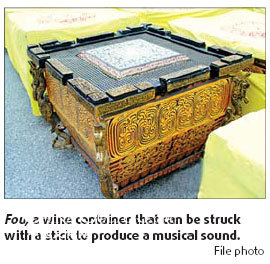more>>More News
- National Day
- ways to integrate into Chinese style life
- Should they be in the same university with me?!!
- Chinese Ping Pang Legend: the Sun Will Never Set
- A Glance of those Funny University Associations
- mahjong----The game of a brand new sexy
- Magpie Festival
- Park Shares Zongzi for Dragon Boat Festival
- Yue Fei —— Great Hero
- Mei Lanfang——Master of Peking Opera
2008 Beijing Olympic Games Opening Ceremony: Instrumental in Spreading the Word
By admin on 2014-12-12
August 8th, Beijing — The 29th Olympic Opening Ceremony was a unique opportunity to introduce Chinese culture to the rest of the world. Furthermore, a vital element of the ceremony was its music, which featured many traditional Chinese instruments.
 Chen Leiji, 41, was one of many musicians at the ceremony
but he attracted greater attention because of the instrument he played
immediately after the flag-raising ceremony. Guqin, a seven-stringed zither-like
instrument, has been regarded as the epitome of Chinese music, philosophy and
culture for 3,000 years.
Chen Leiji, 41, was one of many musicians at the ceremony
but he attracted greater attention because of the instrument he played
immediately after the flag-raising ceremony. Guqin, a seven-stringed zither-like
instrument, has been regarded as the epitome of Chinese music, philosophy and
culture for 3,000 years.
Born into a musician's family in Shanghai, Chen began learning guqin at age 9 and studied with master Gong Yi at the Shanghai Conservatory of Music before leaving for France in 1989 to study piano, composition and conducting.
His four-year trip to Europe not only provided him extensive experience with dozens of orchestras but also deepened his understanding of the Chinese music tradition.
"After learning Western music, which is very strict, I came to love the freedom of guqin," says Chen.
While the score in guqin music records the position and gesture of the hands, the rhythm is not dictated. As a result, says Chen, "each player can have his or her own understanding of the same piece".
Symbolism runs deep in guqin music reflecting its supreme ability to put man in touch with nature. Its strings, for instance, symbolize gold, wood, water, fire and earth - five basic elements of the universe. Emperors Wenwang and Wuwang, who founded the Zhou Dynasty in the 11th century BC, added two more strings to the instrument, which signifies the grave nature of this instrument.
 Ancient
Chinese scholars regarded playing guqin with a few friends in the pine forest or
bamboo grove as one of life's greatest pursuits. It was also popular for the
guqin player to chant or sing poems.
Ancient
Chinese scholars regarded playing guqin with a few friends in the pine forest or
bamboo grove as one of life's greatest pursuits. It was also popular for the
guqin player to chant or sing poems.
At the Opening Ceremony, Chen played guqin with many other instruments for specially-written musical scores. These other instruments carry equally profound meanings in Chinese culture.
One of them was fou, a pottery wine container that can be struck with a stick to produce a musical sound. The Book of History written by Sima Qian (145-c.90 BC), said that when the Dukes of Qin and Zhao met in Mianchi (in today's Henan province) in 279 BC, the Duke of Qin pretended to be drunk and asked his counterpart to play se (a stringed instrument).
When the Duke of Zhao finished, a Qin historian on the
site immediately noted that the Duke of Qin "ordered" the Duke of Zhao to play
music, a gesture of one-upmanship.
Lin Xiangru, a wise prime minister
serving the Duke of Zhao, asked the Duke of Qin to play fou, which was popular
in Qin. When he was refused, Lin said: "If Your Highness doesn't play, in five
steps, I am willing to spray the blood of my neck onto Your
Highness."
Not far away, Lian Po, a great general of Zhao, had a big army massed on the border, ready to rescue his king if necessary. Finally, the Duke of Qin struck a fou with a stick. Lin noted this: On that day, the Duke of Qin played fou "for" the Duke of Zhao.
The interesting anecdote shows the importance of music in Chinese history. Ancient Chinese rulers had seen music as a way of enlightening people, and to use a modern expression, creating a harmonious society.
 Back in the
Zhou Dynasty that spanned eight centuries until 256 BC, music was part of a
strict ritual system that upheld the social stratum. While the emperor enjoyed
musical bells and chimed stones that lined on four sides, the dukes only had
bells and stones on three sides.
Back in the
Zhou Dynasty that spanned eight centuries until 256 BC, music was part of a
strict ritual system that upheld the social stratum. While the emperor enjoyed
musical bells and chimed stones that lined on four sides, the dukes only had
bells and stones on three sides.
The requirements were not so strict by the time of the great philosopher and educator Confucius (551-479 BC), who saw this as a sign of a collapsing social order. Throughout his life, Confucius avidly learned about ancient rituals and music, which formed a main part of his teaching.
The oldest musical instruments found in China were the bone flutes unearthed in 1987 from Jiahu, Henan province. Dating back more than 8,000 years, the flutes were drilled with five to eight holes on bones of cranes and other animals.
It is fascinating that one of the flutes had been broken into three parts before being buried next to its owner. But the pieces were linked together with thin thread, showing the great love it once enjoyed.
As the animal bones vary in length and thickness, ancient musicians made marks on the bones to find out the best places to drill holes that would produce harmonious musical notes. Today, some of the bone flutes are on display at the Capital Museum in Beijing.
Many people mix the guqin with another stringed instrument called the guzheng, which was also featured at the Opening Ceremony with a dozen players. Producing a much louder sound with happier and faster tones, this instrument usually has 25 strings. While the guqin is an aloof solo instrument, only occasionally played with the se, ruan (stringed instrument) or xiao flute, guzheng has a taste of the grassroots, with folk tunes forming a big part of its repertoire.
 Another instrument that generates rapid music is pipa. In the
Dunhuang Mogao grottoes in Northwest China's Gansu province, one mural depicts a
flying aspara, or Buddha's attendant, plucking the strings of a pipa behind her
head while balancing herself on one foot.
Another instrument that generates rapid music is pipa. In the
Dunhuang Mogao grottoes in Northwest China's Gansu province, one mural depicts a
flying aspara, or Buddha's attendant, plucking the strings of a pipa behind her
head while balancing herself on one foot.
This mural was probably inspired by the performances in the imperial court of the Tang Dynasty, which has inspired a lot of the costumes and scenes in the Opening Ceremony. While imperial music in the Zhou Dynasty had been solemn and ritualistic, Tang rulers were more down to earth and pursued extravagant recreations.
Also in the ensemble was the sheng, a reed pipe wind
instrument whose history also goes back for thousands of years. In the Tang
Dynasty, the sheng had 17 pipes, although another two could be added when
necessary.
The Olympic Opening Ceremony again displayed the efforts of
modern Chinese musicians to create new music with ancient
instruments.
"Music is a genuine universal language that knows no boundaries," says Chen, who also teaches students the instrument from his guqin studio in Beijing.
- Contact Us
-
Tel:
0086-571-88165708
0086-571-88165512E-mail:
admission@cuecc.com
- About Us
- Who We Are What we do Why CUECC How to Apply
- Address
- Study in China TESOL in China
Hangzhou Jiaoyu Science and Technology Co.LTD.
Copyright 2003-2024, All rights reserved




 Chinese
Chinese
 English
English
 Korean
Korean
 Japanese
Japanese
 French
French
 Russian
Russian
 Vietnamese
Vietnamese
